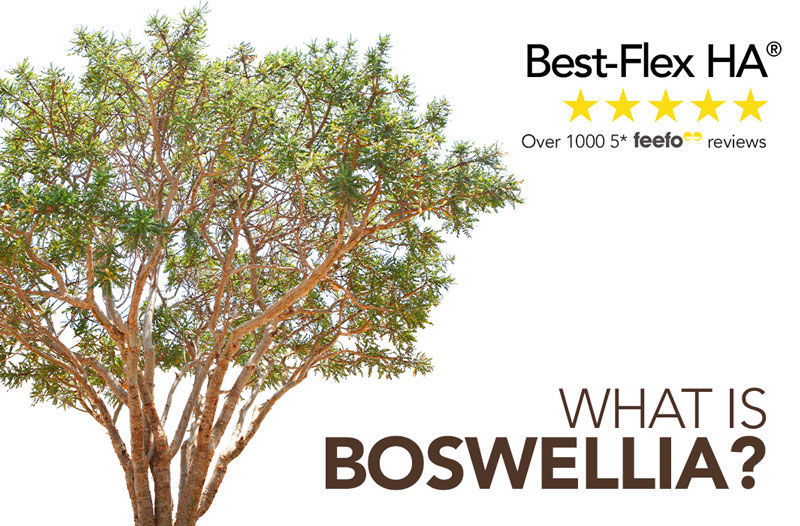Boswellia Serrata is a moderate sized branching tree that grows in India, Northern Africa and the Middle East (Bampidis et al, 2022), and the resin from the tree has been used in ancient medicine for over 8,000 years (Siddiqui, 2011). The resin is obtained by making a small incision in the tree’s trunk and is then allowed to dry for about a month. The remaining gum-resin slowly hardens and is then broken into pieces and all impurities are removed (Siddigui, 2011).
Boswellia resin contains the boswellic acids, Beta-boswellic acid, keto-beta-boswellic acid, and acetyl-keto-beta-boswellic acid, which are the active components of Boswellia. These active components have been shown to reduce inflammation and help with conditions such as osteoarthritis, rheumatoid arthritis, asthma and inflammatory bowel disease.
How do Boswellic acids help with inflammation?
Boswellic acids inhibit the synthesis of the pro-inflammatory enzyme, 5-lipoxygenase (Ammon, 1995; Wildfeuer, 1998; Ammon, 2006). 5-lipoxygenase enzyme creates inflammatory leukotrienes, which cause inflammation by promoting free radical damage, calcium dislocation, cell-adhesion and migration of inflammation-producing cells to the inflamed areas of the body (Siddigui, 2011). In addition, an early in vivo study showed that the use of Boswellia considerably reduced the degradation of glycosaminoglycans compared to controls (Reddy et al, 1989). Glycosaminoglycans are used in the body as a lubricant for joints and are therefore vital for optimal joint health.
Boswellic acids and joint health
Boswellic Acids have anti-arthritic and anti-inflammatory properties and whilst there have not been many peer reviewed studies to show the effects of Boswellia on horse joint health, there have been several studies on humans and other animals that show positive results. Clinical trials in humans have shown that supplementing the diet with Boswellia has been shown to improve symptoms in patients with osteoarthritis, and rheumatoid arthritis. A recent study, conducted in 2017, found that knee osteoarthritis can also be successfully managed with Boswellia, especially when Nonsteroidal anti-inflammatory drugs do not provide relief (Karimifar, 2017). Another recent study in rats showed that active extract of Boswellia lessened the inflammation observed by changes in inflammatory parameters of joint-like reduction in ankle diameter, paw volume, and arthritis index. The authors concluded that this result was due to anti-inflammatory action of Boswellia (Kumar et al, 2019). In dogs Boswellia was shown to significantly reduce clinical signs of arthritis in 71% of dogs studied in 6 weeks of treatment (Reichling et al, 2004). Dogs were monitored for several parameters including intermittent lameness, local pain, stiff gait, lameness when moving, and lameness after a long rest. All parameters showed statistically significant improvement at the end of the trial.
Boswellia in Best-Flex HA®
When fed at the recommended daily rate Best-Flex HA® will provide 12000mg Boswellia. In line with our promise to always provide the best possible products, we source the finest quality Boswellia we can from suppliers aligning to the same strict feed assurance schemes as ourselves and with the highest possible levels of Boswellic acid.
References
- Ammon, H.P. (1996) ‘Salai guggul-Boswellia serrata from a herbal medicine to a specific inhibitor of eukotriene biosynthesis’ Phytomedicine, 3, page 67-70.
- Ammon, H.P. (2006) ‘Boswellic acids in chronic inflammatory diseases’ Planta Med, 72(12), pages 1100-16
- Bampidis, V., Azimonti, G., Lourdes Bastos, M., Christensen, H., Durjava, M., Kouba, M., Lopez-Alonso, M., Lopez, S., Marcon, F., Mayo, B., Pechova, A., Petkova, M., Ramos, F., Sanz, Y., Villa, R.E., Woutersen, R., Brantom, P., Chesson, A. and Westendorf, J. (2022) ‘Safety and efficacy of a feed additive consisting of an extract of olibanum from Boswellia serrata Roxb. ex Colebr. for use in dogs and horses’, EFSA Journal
- Karimifar, M., Soltani, R., Hajhashemi, V. and Sarrafchi, S. (2017) ‘Evaluation of the effect of Elaeagnus Angustifolia alone and combined with Boswellia thurifera compared with ibuprofen in patients with knee osteoarthritis: a randomized double-blind controlled clinical trial’, Clinical Rheumatol, 36, pages 1849–1853 (2017)
- Kumar, R., Singh, S., Saksena, A. K., Pal, R., Jaiswal, R., & Kumar, R. (2019). ‘Effect of Boswellia Serrata Extracts on Acute Inflammatory Parameters and Tumor Necrosis Factor-α in Complete Freund’s Adjuvant-Induced Animal Model of Rheumatoid Arthritis’, International journal of applied & basic medical research, 9(2), page 100–106.
- Reddy, G.K., Chandraksan, G., and Dhar, S.C. (1989) ‘Studies on the metabolism of glycosaminoglycans under the influence of new herbal ant-inflammatory agents’, Biochem Pharm, 38:35, pages 27-34.
- Reichling, J., Schmökel, H., Fitzi, J., Bucher, S. and Saller, R. (2004) ‘Dietary support with Boswellia resin in canine inflammatory joint and spinal disease’, Schweiz Arch Tierheilkd, 146(2), pages 71-9.
- Siddiqui, M. Z. (2011) ‘Boswellia Serrata, A Potential Anti-inflammatory Agent: An Overview’, Indian Journal of Pharmaceutical Sciences, 73(3), pages 255–261.
- Singh, D., Nainwani, R., Sharma, T. and Gautam R. (2013) ‘In-Vitro Anti-Inflammatory and Anti-Arthritic Activity of Hydroalcoholic Extract of Pongamia Pinnata (L.) Pierre Seed’, International Journal of Pharma Research & Review, 2(12), pages 20-25
- Wildfeuer, A., Neu, I.S., Safayhi, H., Metzger, G., Wehrmann, M., Vogel U, and Ammon, H (1998) ‘Effects of boswellic acids extracted from a herbal medicine on the biosynthesis of leukotrienes and the course of experimental autoimmune encephalomyelitis.’ Arzneimittel-Forschung; 48(6), page 668-74 .


